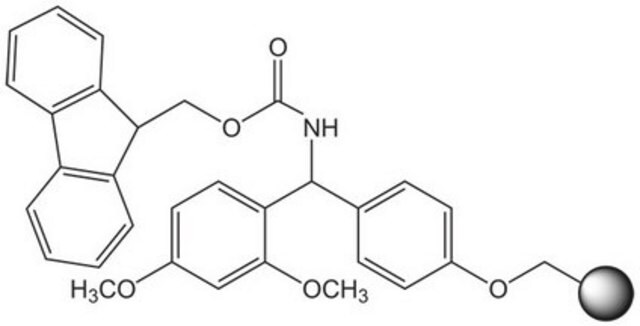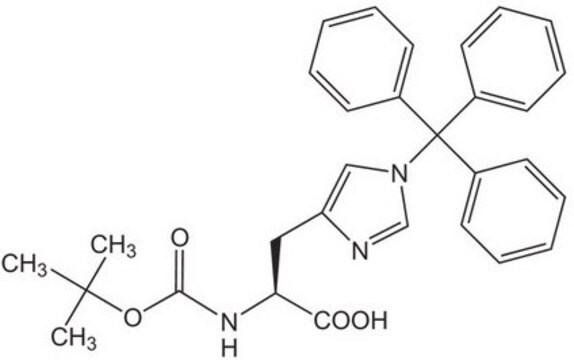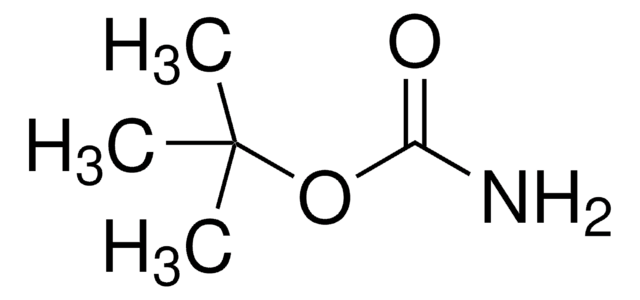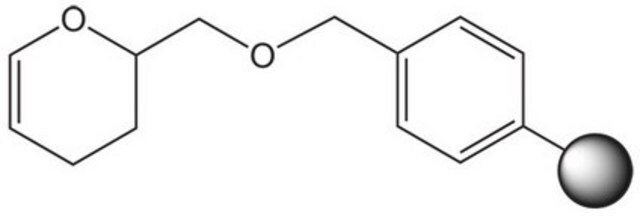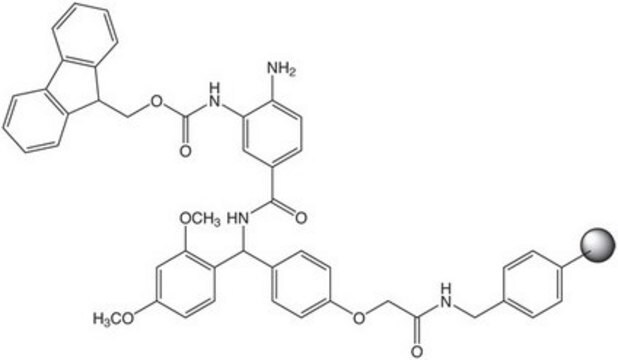8.55035
DFPE polystyrene
Novabiochem®
Synonim(y):
2-(3,5-Dimethoxy-4-formylphenoxy)ethyl polystyrene
Zaloguj sięWyświetlanie cen organizacyjnych i kontraktowych
About This Item
Kod UNSPSC:
13111023
NACRES:
NA.22
Polecane produkty
Poziom jakości
linia produktu
Novabiochem®
Postać
beads
przydatność reakcji
reaction type: Fmoc solid-phase peptide synthesis
producent / nazwa handlowa
Novabiochem®
Zastosowanie
peptide synthesis
grupa funkcyjna
aldehyde
temp. przechowywania
2-8°C
Opis ogólny
This resin is prepared under conditions optimized to minimize styrene formation during attachment of the linker to the functionalized ethylpolystyrene support. This high substitution, coupled with the lack of amide bonds and potentially acid-sensitive benzylic linkages, makes this support the preferred choice of SPOS of secondary sulfonamides and carboxamides. Applications of FMPE include aminofurazanopyrazines [1] and peptide agonists for human orphan receptor BRS-3 [2].
Associated Protocols and Technical Articles
Protocols for Loading of Peptide Synthesis Resins Literature references
Literature references
[1] B. Dörner & P. White in ′Peptides 1998, Proc. 25th European Peptide Symposium′, S. Bajusz & F. Hudecz (Eds), Budapest, Akadémiai Kiadó, 1999, pp. 90.
[2] M. Grimstrup & F. Zaragoza (2002) Eur. J. Org. Chem., 2953.
[3] K. J. Jensen, et al. (1998) J. Am. Chem. Soc., 120, 5441.
[4] M. del Fresno, et al. (1998) Tetrahedron Lett., 39, 2639.
[5] N. S. Gray, et al. (1997) Tetrahedron Lett., 38, 1161.
[6] J. Alsina, et al. (1999) Chem. Eur. J., 5, 2787.
[7] J. F. Tolborg & K. J. Jensen (2000) Chem. Commun., 147.
[8] A. E. Fenwick, et al. (2001) Bioorg. Med. Chem. Lett., 11, 195.
[9] J. Giovannoni, et al. (2001) Tetrahedron Lett., 42, 5389.
[10] J. T. Bork, et al. (2003) Org. Lett., 5, 117.
[11] C. P. Holmes, Paper ORGN 383 presented at the 213th National Meeting of the American Chemical Society, San Francisco, 1997.
[12] C. Pégurier, et al. (2000) Bioorg. Med. Chem., 8,163.
[13] T. F. Herpin, et al. (2000) J. Comb. Chem., 2, 513.
Associated Protocols and Technical Articles
Protocols for Loading of Peptide Synthesis Resins Literature references
Literature references
[1] B. Dörner & P. White in ′Peptides 1998, Proc. 25th European Peptide Symposium′, S. Bajusz & F. Hudecz (Eds), Budapest, Akadémiai Kiadó, 1999, pp. 90.
[2] M. Grimstrup & F. Zaragoza (2002) Eur. J. Org. Chem., 2953.
[3] K. J. Jensen, et al. (1998) J. Am. Chem. Soc., 120, 5441.
[4] M. del Fresno, et al. (1998) Tetrahedron Lett., 39, 2639.
[5] N. S. Gray, et al. (1997) Tetrahedron Lett., 38, 1161.
[6] J. Alsina, et al. (1999) Chem. Eur. J., 5, 2787.
[7] J. F. Tolborg & K. J. Jensen (2000) Chem. Commun., 147.
[8] A. E. Fenwick, et al. (2001) Bioorg. Med. Chem. Lett., 11, 195.
[9] J. Giovannoni, et al. (2001) Tetrahedron Lett., 42, 5389.
[10] J. T. Bork, et al. (2003) Org. Lett., 5, 117.
[11] C. P. Holmes, Paper ORGN 383 presented at the 213th National Meeting of the American Chemical Society, San Francisco, 1997.
[12] C. Pégurier, et al. (2000) Bioorg. Med. Chem., 8,163.
[13] T. F. Herpin, et al. (2000) J. Comb. Chem., 2, 513.
Powiązanie
Replaces: 01-64-0360
Komentarz do analizy
Color (visual): white to yellow to beige
Appearance of substance (visual): beads
Loading (determined by elemental analysis of sulfur after derivatization with tosylhydrazide): 0.50 - 1.10 mmol/g
Swelling Volume (in DMF): lot specific result
The polymer matrix is copoly (styrene-1 % DVB), 100 -200 mesh
Appearance of substance (visual): beads
Loading (determined by elemental analysis of sulfur after derivatization with tosylhydrazide): 0.50 - 1.10 mmol/g
Swelling Volume (in DMF): lot specific result
The polymer matrix is copoly (styrene-1 % DVB), 100 -200 mesh
Informacje prawne
Novabiochem is a registered trademark of Merck KGaA, Darmstadt, Germany
This page may contain text that has been machine translated.
Kod klasy składowania
11 - Combustible Solids
Klasa zagrożenia wodnego (WGK)
WGK 1
Temperatura zapłonu (°F)
Not applicable
Temperatura zapłonu (°C)
Not applicable
Certyfikaty analizy (CoA)
Poszukaj Certyfikaty analizy (CoA), wpisując numer partii/serii produktów. Numery serii i partii można znaleźć na etykiecie produktu po słowach „seria” lub „partia”.
Masz już ten produkt?
Dokumenty związane z niedawno zakupionymi produktami zostały zamieszczone w Bibliotece dokumentów.
Nasz zespół naukowców ma doświadczenie we wszystkich obszarach badań, w tym w naukach przyrodniczych, materiałoznawstwie, syntezie chemicznej, chromatografii, analityce i wielu innych dziedzinach.
Skontaktuj się z zespołem ds. pomocy technicznej